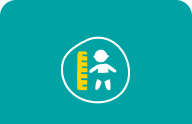Neonatal Intensive Care Unit (NICU): Tests
The following alphabetized list explains some of the NICU tests and assessments your baby might have in NICU hospitals. This info will help you better understand and support your preemie.
And for more information to help familiarize yourself with the NICU, be sure to check out the related guides that cover NICU staff, equipment, and common conditions.
Common Test in The Neonatal Intensive Care Unit
Behavioral Exam. This is a formal NICU assessment of your baby's behavior and development, which most infants have at least once during their stay in the NICU. Measurements are taken using tools like the Neonatal Behavioral Assessment Scale (NBAS), the Assessment of the Premature Infant's Behavior (APIB), or another method. If you can, try to be there for this evaluation—it’s amazing to see all the things your little one can do and how they change and mature over time.
Blood Tests. Blood tests are some of the most frequent NICU tests. The sicker or more unstable your baby is, the more often they'll need a blood test. These tests can tell if your baby is anemic or if bilirubin levels are too high. They show whether your baby has low blood sugar (hypoglycemia) or salt or water imbalances, all of which can cause problems if not corrected. Blood tests can also determine whether your baby has an infection and, if so, which antibiotic should be used to treat it. Blood may be drawn from an intravenous or arterial line, from a vein, or from a prick on your baby's heel.
Blood-Gas Tests. These tests NICU tests measure the oxygen and carbon dioxide levels in your baby's blood. Blood gases are checked frequently in infants with lung or heart problems to keep them balanced. Test results show whether the ventilator needs adjusting or if additional testing or intervention is needed. Blood gases are sampled from an arterial line placed in the wrist or ankle or through the umbilical cord. They can also be sampled from a heel prick after warming the heel, a procedure sometimes called a "capillary gas. " The oxygen and carbon dioxide levels are referred to as pO 2 and pCO 2 . If your baby is very sick, testing might be required several times per hour.
Car Seat Safety. Before you take your baby home, healthcare providers need to ensure they can sit in a car seat without any breathing problems. You'll be asked to bring your car seat; your baby will be placed in it and connected to a breathing monitor and oximeter. If their position causes any breathing issues, adjustments must be made before you leave.
Computed Tomography (CT Scan). An advanced type of X-ray that focuses a beam of energy on the tissue the healthcare provider wants to examine, using computers to create a two-dimensional image. This scan is usually done of the brain but can be used to visualize many body areas. For the test, your baby will be taken to the hospital's radiology department and may be sedated so they don't move.
Echocardiogram. A specialized ultrasound exam used to study the structure and function of the heart. Sometimes referred to simply as an "echo," it provides detailed images of your baby's heart.
Electroencephalogram (EEG). A NICU brain wave test looking for seizures or other irregularities in brain function. Small sensors are applied to the scalp (they don't hurt), and a recording is made of the brain's electrical activity over time.
Electrocardiogram (ECG or EKG). A recording of the heart's electrical activity, crucial for preterm newborn screening to ensure accurate monitoring of heart rhythm and development. Small sensors on the chest and other parts of the body pick up impulses from different angles to see if there are any irregularities in heart rhythm or voltage changes.
Gestational Age Evaluation. A NICU assessment to check your baby's maturity using physical features like skin thickness and neurological signs such as flexibility. These findings are compared with standards to determine how mature your infant is at birth—essentially, how long they were in the uterus. This assessment is particularly important in preterm newborn screening as it helps guide appropriate care. Sometimes, maternal dates based on the last menstrual period are unknown or inaccurate, so the baby's features help healthcare providers evaluate how their development compares with other infants.
Hearing Tests. Premature and sick babies are at increased risk of hearing problems. Before your baby goes home, as part of the preterm newborn screening, they will likely have a hearing test: either a Brainstem Auditory Evoked Response test (BAER) done by an audiologist or an Otoacoustic Emission test (OAE) done by a nurse or technician. Small sensors taped to your baby's head relay information to a machine that measures the electrical activity in their brain in response to sound. Tiny earphones are placed in the ears, and sounds are delivered through a range of frequencies and loudness levels. If your baby responds normally, they probably have normal hearing. Repeat testing may be needed at 9 to 12 months, or even sooner if your baby fails one of these tests or if they are very small or ill at the time of the original testing.
Magnetic Resonance Imaging (MRI). An imaging technique that, like a CT scan, produces a detailed picture of tissue that may be difficult to see on an X-ray or ultrasound. MRI may be used to visualize the brain or another part of the body. This NICU test gives a more detailed view than a CT scan for most conditions but requires sedation to keep your baby very still during a noisy and somewhat lengthy procedure. An MRI uses no radiation; instead, it employs powerful magnets and computers to create an image. Your baby will be taken to the radiology department for this test.
Newborn Screening Test. A test performed by pricking your baby's heel to obtain a few drops of blood on filter paper. Also known as a PKU or NBS test, this procedure checks for serious hereditary disorders. This is a standard procedure in preterm newborn screening. Most states require screening for several disorders. Testing may need to be repeated in a preterm infant if the first test was done very early, before feeding was established, or if it was done after a blood transfusion.
Temperature Measurements. In a preemie, skin temperature, under-the-arm (axillary) temperature, and rectal temperature are likely to be close to one another because your baby is so small. Oral temperature and ear temperature measurements are not accurate in small infants.
Ultrasound. A procedure using sound waves (rather than X-rays) to create an image of your baby's organs. A small handheld device called a transducer is moved over the area the healthcare provider wants to see. An ultrasound exam is painless and can be done during NICU monitoring. An ultrasound (also called a sonogram) of the head is the usual test to diagnose bleeding in the brain. Other organs can be visualized as well. You might hear the pictures referred to as "echos," like "head echo," "heart echo," or "kidney echo."
Urine Tests. Urine tests are another common NICU test that can tell a lot about your baby's overall condition. They can show how well the kidneys are functioning and whether your baby has an infection. Healthcare providers can collect urine by placing a bag collecting system over the genitals ("bagging"), inserting a small tube into the bladder ("catheterization"), or using a needle and syringe to draw urine directly from the bladder (a bladder tap).
Weighing. Your baby will be weighed soon after delivery and then at least once a day while in the NICU. Don't be alarmed if your baby loses some weight after birth or if their weight varies from day to day at first. This is normal, especially for very small babies. When a premature baby starts gaining weight steadily, it's an encouraging sign. Each baby has a weight chart at their bedside so healthcare providers can compare their weight with what's expected for their adjusted age. Steady weight gain is an important step before hospital discharge. Weight is usually measured in grams for NICU babies. Understanding your baby's growth is essential, and you can learn more about premature babies' development.
X-Ray. A diagnostic tool that provides pictures of your baby's lungs and other internal organs. These pictures help the healthcare provider plan treatment and monitor progress. Your baby may require several lung X-rays each day if they have serious breathing problems or if there are concerns about heart function. X-rays are usually performed after every placement of a breathing tube or any change in your baby's condition. For more information on related topics, you can check out this article on premature birth.
Join a World of Support
through Pregnancy and Parenthood.
TRACK WITH TOOLS
LEARN WITH EXPERTS
GET REWARDED












